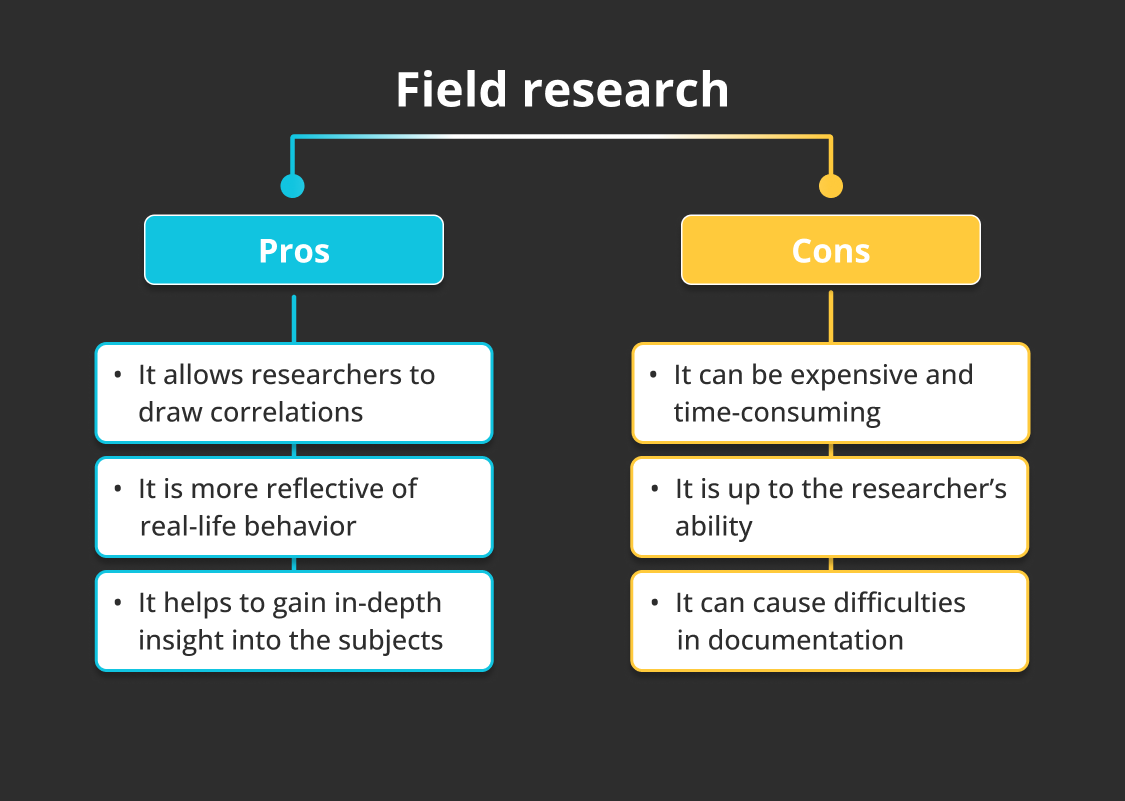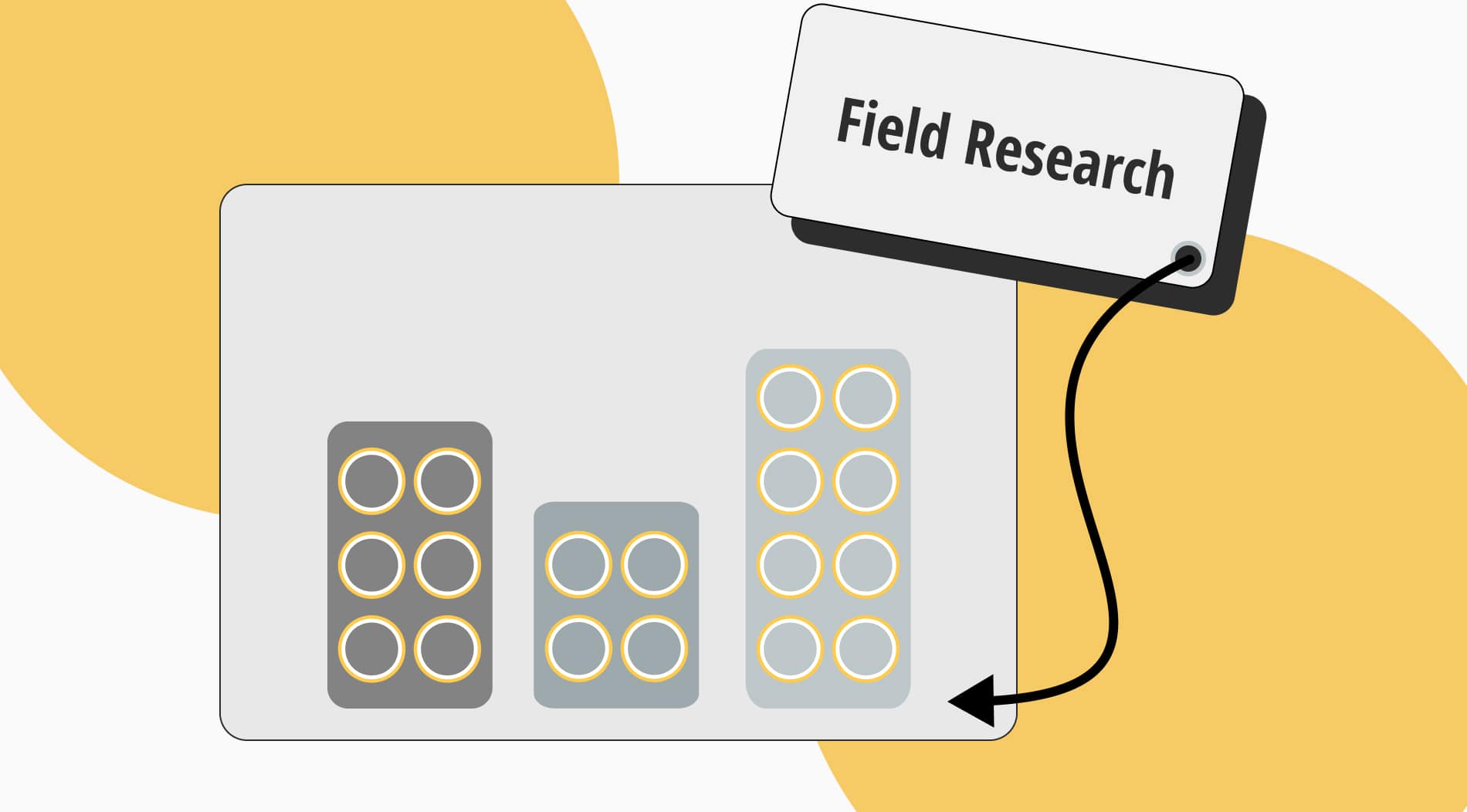Ever wondered how scientists draw conclusions on groups of people? Or want to know what are the common characteristics of people living in rural areas? Well, when the aim of the study is to explain people’s lives and characteristics through their natural environment, field research is usually the best method scientists choose to go with. The researcher can observe communities, cultures, groups of people, or individuals.
In this article, we discuss the definition, types, and methods of field research and provide some examples of field research. With all this information and the pros and cons of field research, you can make a conscious decision about your next research. Let us get started with the definition!
What is field research?
Field research is a qualitative method of research where its main concern is conducting research on individuals about the social setting they are in.
The main focus of field research is understanding and interpreting groups of people, societies, and communities through observation in real-world settings. This research design opens a brand new perspective to any concept, pre-explored or not.
Why and when to conduct field research?
Field research is an effective method of data collection when the main research topic is about a group of people and the environment they live in. Social scientists try and explore the cause-and-effect relationships between humans and their natural environment. It also gives in-depth information on specific subjects. And, in which circumstances would you need to conduct a field study?
1. When you want to understand the concept of the study
Field research allows scientists to draw conclusions from the data gathered from a focus group and their environment. In some instances, there may be studies conducted on the same subject matter. However, the studies conducted may be insufficient and give improper conclusions. In this instance, a field study can shed light on events.
2. When there is a lack of data
This method can be used to fill the gaps only different data collection methods can. Usually, on a specific subject, knowledge gathered from previous case studies tends to be limited. And they can only be proven right or wrong by conducting primary research using mixed methods. Field research is a great way to cross-reference what is already known.
3. When you want to acquire high-quality data
Researchers conducting various methods obtain different types of data that can be successfully analyzed via the triangulation method. When more than one research method is used to essentially “fact-check” the data, it proves the accuracy of the information.
4 field research methods
Different research methods can be used according to the aim of the study. There are 4 main field research methods, and it is up to the head researcher to use which one. Sometimes, it is a good idea to mix more than one method as well. Let us see the field research methods:

4 methods to conduct field research
1. Direct observation
This is the type of field research method where the researcher has no interventions to the subjects and their environment. The whole purpose of this method is to directly observe the subject in their natural world and draw conclusions.
2. Participant observation
In this field research method, the researcher is not merely an observer but one of the participants. The environment is the same as the direct observation, but this time, the researcher can be an active participant. With good skills in communication and interpersonal relations, the researcher can encourage subjects to engage in discussions effectively.
3. Qualitative interviews
The method of qualitative interviews is achieved when close-ended questions are directly asked to the research subjects. Qualitative interviews provide solid data from a number of sources and can be performed through focus groups, written surveys, and individual interviews. Also, they could be informal, conversational, semi-structured, open-ended, or a mix of all of them.
4. Ethnography
This is a type of field study that records and analyzes cultures, communities, regions, and societies. In ethnography, entire communities or individuals are studied to gain an in-depth perception of cultural values, societal perspectives, and social structure. The field researcher can observe the communities from afar or live among them and silently observe their day-to-day lives.
How to conduct field research (Step by step)
When you have an objective in mind and want to do field research on the subject to gain insight, there are some steps you should follow. As with every project, a structured plan makes the whole process easier. When you have your study question or know the community you want to explore, you can start with the first step.
1 - Find researchers in the field: You may want to conduct the study yourself, but you can always have outside help.
2 - Clearly identify the topic: It is best to start with a clear study question in mind to have everybody on the same page.
3 - Identify the research method: You can choose one method or have a mix of observations, interviews, surveys, etc.
4 - Visit the site of the study: When the steps above are successfully completed, the researcher can go into the field and start collecting data either with or without observation.
5 - Use effective note-taking:
Usually, field research takes a long time, and effective note-taking is quite crucial so as not to lose any precious data. There is more than one way of doing this. The researcher can use:
- Job notes (short notes taken during the research),
- Field notes (detailed and precise notes),
- Journals and diaries (insightful notes into the life of the researcher),
- Methodological notes (notes about methods used and their progress)
6 - Analyze the data:
Once the data collection is completed, it is time to analyze them carefully.
7 - Communicate the results:
The next and final step is to make a field study report and explain the outcome.
Field research examples
Basically, field research can be successfully used when the aim is to draw correlations between people and their environments. The study can be about marketing, sociology, medicine, or psychology. Let us see some examples of field research:
Field research example #1
A result of some studies show that in poorer neighborhoods, obesity levels being higher and more intense than in richer neighborhoods may be attributed to poor living conditions and lack of parental figures in families. However, data analysis from field research may show that a big factor playing a role in obesity levels is the fact that there are fewer healthy market options and more fast-food restaurants in the area. That finding gives a whole new perspective to the subject.
Field research example #2
The researcher can choose a specific region that has a high population of homeless people and observe their day-to-day life, see how they manage and what are their daily routines. They can go into homeless shelters or streets and observe these people. And they can ask them some pre-planned interview questions to get more information if they want.
Pros and cons of field research
As with every research method, field research also has its pros and cons. It is up to the head researcher to find the best method for their objective. Let us see the advantages of field research and disadvantages of field research to have a better idea.

Pros and cons of field research
Pros of field research
- Field research allows researchers to draw correlations between subjects and their environments
- Field research is more natural than lab research. Therefore, it is more reflective of real-life behavior.
- The researcher is able to gain in-depth insight into the subjects thanks to their proximity to them.
Cons of field research
- Field research may be expensive and time-consuming as some studies may take years to complete.
- Field research is a subjective method and is up to the researcher’s ability.
- Documenting observations can be a challenge as there are many contributing variables.
Key points to take away
Field research is a type of research where researchers can make conscious decisions on communities, cultures, and groups of people. They can find brand new study questions and create new theories, or they can build on what is already known. It is a great way to collect primary data directly from sources. Here are the key points to take away about field research
- Field research is used when there is a lack of data or when high-quality is needed on a subject.
- A structured step-by-step guide answers researchers' questions about the process of the study.
- Taking effective notes during the study is critical.
- Field studies may be too expensive for some and may take years to complete.
- Field research provides insight directly from real-life situations.
- In addition to observations, interviews, and surveys can be used as well.
In conclusion, field research is an effective way to gain insight into people and their environments. It has its own positive and negative aspects, and it is up to the researcher to successfully complete the study. We have gathered this article to explain field research effectively. Lastly, for your research needs and so much more, forms.app is a great helper and can make your day easier with a few buttons!
forms.app, your free form builder
- Unlimited views
- Unlimited questions
- Unlimited notifications



